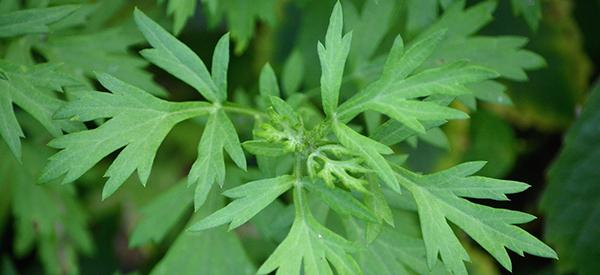
Mugwort
Mugwort (Artemisia vulgaris), or common artemisia, is a spreading perennial herb of the Artemisia family. It is a smokable plant that ancient tribes used to promote vivid dreams because of its mild psychotropic effect. Sleeping on a pillow full of fresh mugwort can induce sacred dreams while warding off insects and mosquitoes. Mugwort is believed to have both medicinal and magical powers. That is why it is popular in traditional rituals and ceremonies for warding off ghosts and evil entities.
Mugwort is also an herb used for flavoring beverages like its close relative Artemisia absinthe or wormwood. While wormwood is used in the controversial absinthe, mugwort is used in beers to give it a pleasant but bitter taste.
The powerful attributes of mugwort have a long history in folk and tradition. The Anglo-Saxon tribes believed that mugwort was one of the Nine Herb Charms gifted to the world by the god Woden. Travelers used the herb to ward off exhaustion on the road and cure aching feet. Accordingly, St. John the Baptist used a girdle and crown of mugwort when he set off into the wilderness as evil protection. That is why the herb is also referred to as St. John’s plant.
Where Mugwort Is Found
Mugwort is native to Europe, Asia, and some parts of Alaska. Its distribution spread in many Eastern and Central USA regions and Canada. They typically flourished in temperate climates and were naturalized in North America. Mugwort often grows better in places with high elevations and meadows with less human traffic, growing acclimated to harsh conditions.
⇒ The Complete Map of Edible Plants: Find Out What You Have in Your Area! (Video)
How To Identify Mugwort
Preferably growing in waste places and embankments, mugwort is characterized as a noxious, alien weed. It is an invasive plant that can grow into a dense mat, spreading through underground rhizomes. This tall, herbaceous, hairy, and aromatic herb bears a cluster of flowers but may cause contact dermatitis in some people.
- Leaves. The mugwort leaves are simple, alternate, and dark green. Its basal leaves are elliptic, oblong, and deeply lobed. The mid-stem leaves are ellipse to ovate and are lobed pinnately or bipinnately.

The leaf margins are toothed, and the leaf underside is covered with dense and matted hairs.
- Flowers. Mugwort has disk flower heads that grow in numbers in panicles. Each flower head is only about 3 to 4 mm wide with rayless florets. At the bud stage, the flowers are white and turn yellowish-green or purplish-brown as they mature.
- Fruits and Seeds. In maturity, the flowers develop into brown or copper achene. It means it is a dry fruit that does not open to release its only seed. The achene is small, lightweight, and egg-shaped.
- Roots. Mugwort is rhizomatous and can spread into an invasive colony. It has an extensive but shallow root system, only about 20 cm deep. The roots are semi-woody, with numerous branching rhizomes.
- Stem. Mugwort has an erect and multi-branching stem. The stems are erect and angular, and can grow from 1 to 2 meters tall. They are purple-brown and are largely hairless except on their flowering stems.
Mugwort is a common name for many species of Artemisia. But the true Artemisia vulgaris is the common mugwort used as a culinary and medicinal herb. It is a member of the Asteraceae or aster family. It is known for many names such as:
- Felon Herb
- St. John’s Plant (not to be confused with St. John’s wort)
- Chrysanthemum weed
- Hierba de San Juan
- Naughty Man
- Sailor’s Tobacco
- Old Uncle Henry
- Green ginger
- Herb royale
⇒ Plant Identification Guide – 400 Wild Plants That You Can Forage For (Video)
How To Grow Mugwort
Mugwort is a resilient plant, but will not always tolerate wet soil conditions. It can grow through seeds or cuttings. In poor soil and dry weather, mugwort may grow small but still live longer and become more aromatic.
In many states, mugwort is considered an invasive weed and is often destroyed when found in the garden. It not only invades the garden, but also releases chemicals that make it difficult for the surrounding plants to survive. Thus, it is best to plant them in an individual container to suppress the spread of its roots. If you don’t want them in containers, plant mugwort in deep borders where it can be isolated.
Growing Mugwort from Seeds
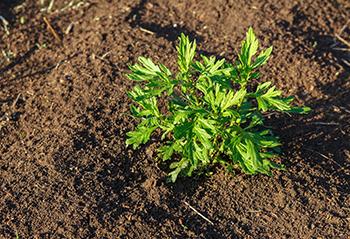 A cold stratification process will give mugwort seeds a better germination rate. They are also best for planting in late fall or early spring. Apply cold treatment to the seeds by mixing them with dampened peat moss. Place it in the refrigerator for 2 to 4 weeks before planting.
A cold stratification process will give mugwort seeds a better germination rate. They are also best for planting in late fall or early spring. Apply cold treatment to the seeds by mixing them with dampened peat moss. Place it in the refrigerator for 2 to 4 weeks before planting.
Sow the mugwort seeds in a tray of well-draining soil rich in organic materials. Lightly cover them with soil and place the tray in a sunny spot where it can take in plenty of sunlight. Keep the medium moist until the seeds germinate for about 21 days. They will mature for at least 80 days, which is also the ideal time for transplanting.
Transplant the seedlings in the garden and space the plant at about 12 to 18 inches. Dig a hole similar to the depth in their starter pot, put the plant, and fill it back with soil. Keep the soil moist by watering them. Make sure not to water it too much to prevent root rot.
⇒ 10 Plants That You Should Never Plant Together (Video)
Growing Mugwort from Cuttings
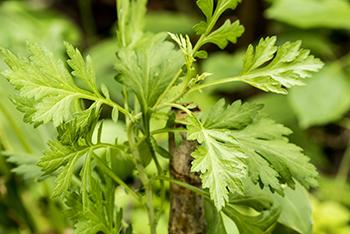 To grow mugwort from cuttings, select a mature and healthy plant. Snip off its stem and remove the leaves from the bottom third of the cutting. Dip the cutting in a rooting hormone and plant it in a 10-inch container of horticultural perlite. You may plant two or three mugwort cuttings in each hole.
To grow mugwort from cuttings, select a mature and healthy plant. Snip off its stem and remove the leaves from the bottom third of the cutting. Dip the cutting in a rooting hormone and plant it in a 10-inch container of horticultural perlite. You may plant two or three mugwort cuttings in each hole.
Water the cuttings until the moisture drips into the drainage and place them in a spot with indirect sunlight. You may cover the pot with a plastic bag for a greenhouse effect and constantly mist the cuttings every couple of days. Transfer the plant into the garden or their permanent containers when the roots are established.
Plant Care and Maintenance
Mugwort is not hounded with diseases and pests because of its natural bug repelling properties. However, it is prone to root rot when the roots are exposed to a soggy environment. But as long as the soil has proper drainage, they can survive even in poor soil conditions.
In USDA Hardiness Zones 4 to 8, mugwort can be grown outdoors. Just keep in mind to keep it under control. Mugwort will grow better under the following conditions:
- Well-draining soil
- Soil pH levels between 6 to 7
- Full sun to partial shade
- Regular watering but not overflowing
How To Harvest Mugwort
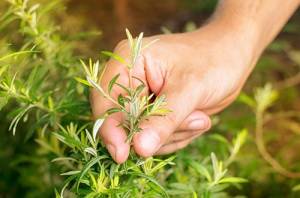 Harvesting the mugwort plant depends on how you are going to use it.
Harvesting the mugwort plant depends on how you are going to use it.
The fresh leaves are harvested anytime throughout the year. Leaves are used either fresh or dried for culinary or medicinal purposes. The young mugwort shoots are ideally harvested in spring before the plant blooms.
The mugwort roots are best collected in autumn. You can preserve it for future use by thoroughly washing the harvested roots and air drying them on screens.
You may also dry the bundled stem and leaves of mugwort by hanging them in small bundles upside down. Do this in a dry place with plenty of air circulation and away from direct sunlight.
What Mugwort Is Good For And Natural Remedies Made From It
Mugwort has many ayurvedic uses and is popular in its effectiveness in treating malaria. It is a source of artemisinin, an active chemical compound extracted from artemisia plants like mugwort. It has long been used for treating malaria since the outbreak in 1970, including the high-drug resistant strains.
Also considered the “dream herb,” mugwort is used as an ingredient in some sleep pillows. It imparts a mild narcotic and sedative property that can induce sleep and bring prophetic dreams. Additionally, it can treat various mood and psychological disorders. This herb brings hope to people with anxiety, depression, and other emotional struggles.
Traditional Chinese Medicine uses mugwort in a healing practice called moxibustion. It involves treating the affected body parts with the smoke from the rolled and ignited mugwort leaves and stems. It is also often used in supplements with acupuncture to improve its effectiveness.
For women, mugwort is an excellent herb to induce menstrual flow to treat scanty menses and irregular menstruation. It is also effective in pain and problems associated with women’s monthly cycle and menopause.
Chinese women had also used mugwort moxibustion as a home therapy for breech pregnancy. The practice prompted some research studies to determine its effectiveness. According to it, mugwort did not necessarily lower the cases of caesarian deliveries, but it did show a positive result. Mugwort moxibustion may reverse breech pregnancy into cephalic presentation within two weeks of use.
Mugwort is a bitter herb that has excellent digestive and stomachic properties. It alleviates many gastrointestinal symptoms and cures bloating and indigestion. It is also a vermifuge for the effective dispelling of parasitic worms.
⇒ The Most Powerful 40 Remedies You Can Find in The Wild (Video)
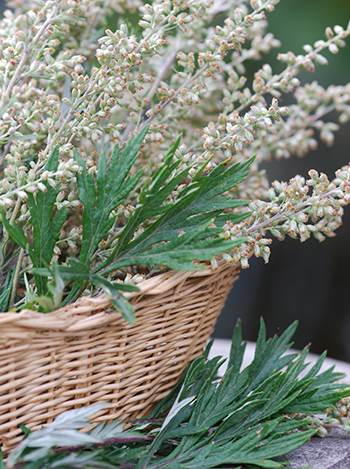
To summarize, you can use mugwort for the following conditions:
- Digestion problems
- Breech pregnancy
- Malaria
- Mood and emotional health problems
- Female reproductive system ailments
- Epilepsy and hysteria
- Asthma and other respiratory disorders
- Intestinal worms
- Anorexia
- Wound treatment
- Skin diseases
- Joint and muscle pain, fatigue
- Cancer
⇒ A Simple “At-Home” Protocol for the Flu and Other Respiratory Issues (Video)
What Parts Of Mugwort Are Used For Remedies?
All parts of the mugwort plant are useful as an herbal home remedy. Its fresh flowers and roots are steeped in tea to alleviate body pains and disorders.
Mugwort roots are tonic and antispasmodic, while its stems are antirheumatic and antispasmodic. The leaves are also made into tea for various stomach problems. It is also put in the soles of the shoes to soothe sore feet.
The paste of mugwort leaves is applied externally for skin problems. Its compressed leaves and stems are used in moxibustion. Its bark is infused and taken for menstrual pain relief.
Mugwort is available in many forms like: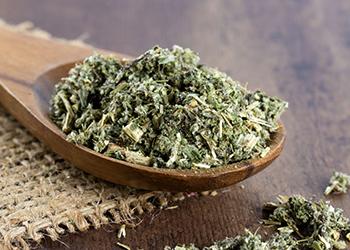
- Powder
- Dried herb
- Tea
- Essential oil and extracts
- Supplements (soft gel, tablet, capsule)
- Tincture
- Smudge sticks
Mood-lifting Mugwort Tea
Ingredients:
- 1 oz or 2 tbsp dried mugwort
- 4 cups of water
- Honey, to taste
Steps:
- Place 2 tbsp of dried mugwort in a teabag, if available. If you don’t have a teabag, you can directly add mugwort into the boiling water later.

- Bring water to a boil in a pot or saucepan and add the dried mugwort. Let it steep for about 5 to 10 minutes. The longer you steep, the bitter the tea becomes.

- Remove the teabag (or strain loose particles) from the pot and let it cool for another 3 minutes.

- Transfer into a mug and add honey to the desired taste.

How to use this remedy:
The mugwort tea is best for alleviating menstrual pain, improving digestion, and reducing anxiety and depression. There is no recommended dosage for using mugwort. But, herbalists recommend taking 50 to 100 ml mugwort tea twice or thrice daily.
Warnings And Cautions
Mugwort is not recommended for pregnant women since it stimulates uterine contractions. It may risk bleeding and miscarriage.
Lactating mothers should also not use mugwort because it can cause heartburn in breastfed babies.
When taking mugwort supplements, always follow the recommended dosage. In large amounts, mugwort can cause heartburn and the risk of toxic poisoning. Excessive and long-term use can worsen nervous problems and cause liver damage.
Direct contact with mugwort can cause contact dermatitis. Oral intake may also trigger allergic reactions in people with ragweed, marigold, daisies, and chrysanthemum sensitivities.
Please refer to a qualified health professional before using any herbal supplements. They will also identify probable interactions when taking any medications. The dosage depends on the health, age, and other conditions of the users. To be safe, follow the product labels and contact your doctor before using mugwort supplements and homemade remedies.
You may also like:
 Mugwort Pillow for Insomnia and Anxiety
Mugwort Pillow for Insomnia and Anxiety
Grow This Plant For Extra Income (It’s So Easy You Can Even Do It Indoors) (Video)
How To Grow Your Own Lavender From Cuttings






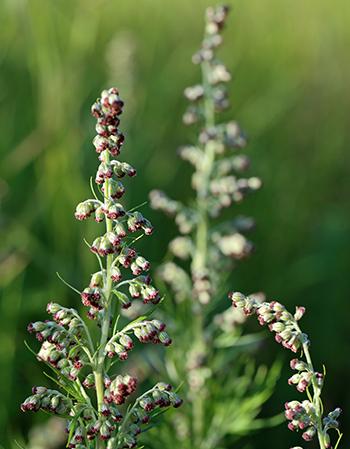
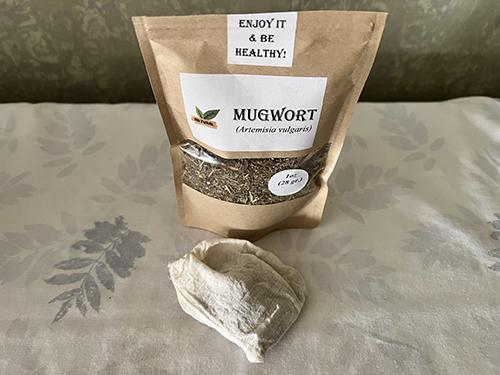
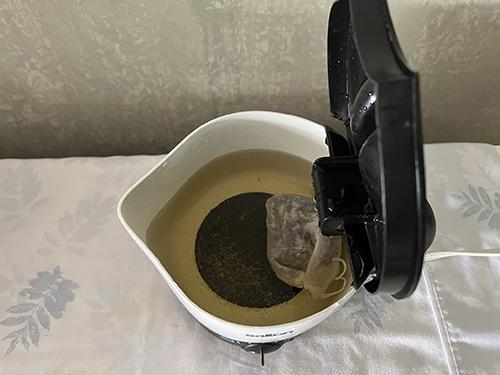
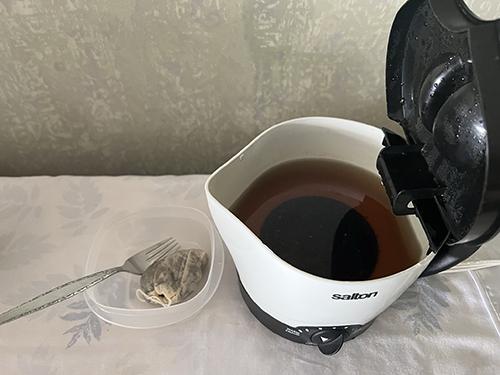
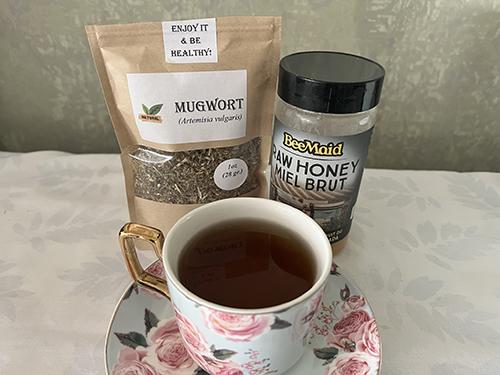


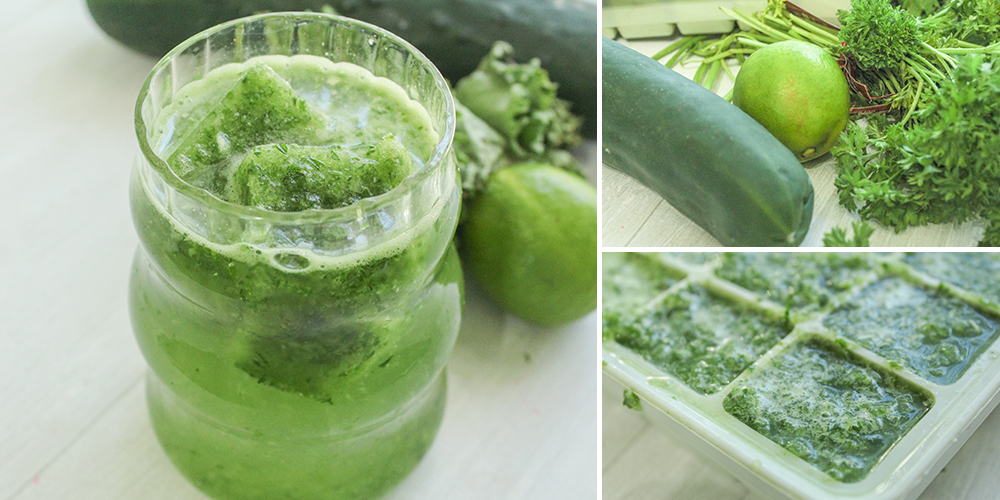
Good herb for post COVID infection or vaccine reaction.
I’m glad I found this website! It teaches me about a lot of herbal remedies that I never knew. Thanks team “ the lost herbs” for your dedication in making me aware and better feeling human. ☺️